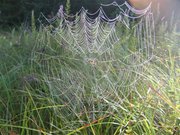Spider web
|
|
Dewy_spider_web.jpg
Cobwebs_on_fence.jpg
Spider_web.jpg
Spider's_web.jpg
A spider web, spiderweb, spider's web or cobweb (from the obsolete word "coppe", meaning "spider" [1] (http://www.askoxford.com/concise_oed/cobweb?view=uk)) is a device built by a spider out of proteinaceous spider silk extruded from its spinnerets. The most familiar spider webs are those used for catching flying insects, but some are used to ensnare small vertebrates, and others only provide shelter. Webs typically contain multiple types of strands, including sticky and non-sticky ones. Some of these strands are stronger than steel strands of the same thickness; the microstructure of this material is under investigation for potential applications in industry.
In spiders, there are several glands located at the spider's abdomen which produce the silken thread. Every gland produces a thread for a special purpose with several different glands currently identified, although spiders each possess only a few of these glands, never all seven at once.
Normally a spider has three pairs of spinnerets, but there are spiders with just one pair or as many as four pairs of spinnerets, with each spinneret having its own function.
To the curious or ingenious among the perusers of this article, it may not be uninteresting to know that a beautiful impression may be taken on paper of the reticulated web of the field-spider, by sprinkling it finely with any dark-coloured liquid, and placing the paper intended for the impression behind the web, and drawing it gently towards you. The idea that an impression might be produced in this manner was suggested by observing the dew on the web in the morning.
Sources
- Ed Nieuwenhuys, The Spider Web and Thread. March 2002.

